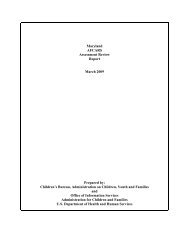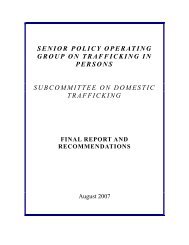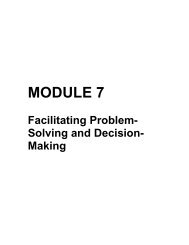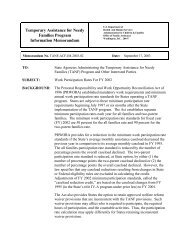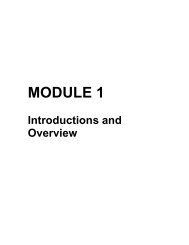Phases of a Systematic Approach to Providing <strong>Technical</strong> <strong>Assistance</strong>One of the core principles above is using a systematic approach when providing TA. If you are developingyour process <strong>for</strong> TA provision or refining your current process, this is a good place to start. Establishinga systematic approach ensures that all beneficiary organizations get equal treatment <strong>and</strong> increases thelikelihood of high-quality TA provision <strong>and</strong>, in turn, measurable outcomes from that TA provision.The four phases in a systematic approach to TA are:1. Request2. Analyze3. Implement4. EvaluateAs with most processes, these phases are not always per<strong>for</strong>med in a linear fashion. You will continue toanalyze as you implement, <strong>and</strong> you could evaluate mid-way through a long-term TA engagement.RequestIn the first phase, the leadership of the beneficiary organization makes a request <strong>for</strong> TA. They could submit aproposal asking <strong>for</strong> large-scale support, approach you in the middle of a TA engagement with an emergency,or call you with an in<strong>for</strong>mal question. Regardless of how the request originates, there is key in<strong>for</strong>mation thatcan be gleaned <strong>and</strong> documented from the request:• Basic in<strong>for</strong>mation, such as the organization’s name <strong>and</strong> date of request.• Narrative description of the presenting problem <strong>and</strong> requested assistance.• Preliminary analysis of underlying issues <strong>and</strong> needs contributing to the presenting problem.• TA action necessary to “fix” the problem.After that in<strong>for</strong>mation has been gleaned, you may receive one of the following responses.1. “Yes, I can help you right now.” If the request requires little action <strong>and</strong> can be met within thesame conversation, you are providing immediate TA. You might answer the question, look up somein<strong>for</strong>mation, offer a brochure or a manual, or direct the organization to a website.2. “Yes, we can work with you.” This answer is, in effect, what you say to an organization that you havethe resources, skills, <strong>and</strong> knowledge to assist. If this is your answer, you will move through the remainingphases of this systematic approach to TA.3. “I’m sorry, we can’t help you with that. Some resources that may be able to help you include…”This is a rejection or a referral. Either way, you are redirecting the requestor away from your TA services.If you are also a training provider, you may refer the organization to your training calendar. Or theremay be another TA provider in your area that can help.If you are receiving a lot of TA requests that can be met by immediate responses, it is important to designatea first responder. This person is responsible <strong>for</strong> fielding the requests, determining which of the three aboveresponses to give, <strong>and</strong> addressing the requests that can be met through immediate TA.14
Alternatively, if you are providing extended TA that spans a significant period of time, it is a good practice toassign the beneficiary organization a case manager, providing consistent contact with a single representativefrom your organization. Case managers often act as advocates <strong>for</strong> the beneficiary organizations they areresponsible <strong>for</strong>, helping them access the tools, resources, <strong>and</strong> services they need.If you are providing extended TA, the request may come by means of an application or proposal writtenby the beneficiary organization <strong>and</strong> submitted to the TA provider. If you are interested in establishingan application or request <strong>for</strong> proposal process, refer to the additional resources in the appendices of thisguidebook.AnalyzeFollowing the request <strong>for</strong> TA, the TA provider needs to analyze. Analysis is used to determine underlyingissues that are behind the request to ensure that the TA provided is properly aligned with the needs of thebeneficiary organization.When entering into a long-term TA engagement, the analysis phase is used to determine all needs that existacross the organization, as well as the goals of the TA engagement. The analysis phase is also an opportunityto build trust with an organization so that they can honestly discuss their challenges with you.Most often this process will be done through an organizational assessment. An organizational assessmentwill identify the most pressing TA needs of the organization. The assessment should be done collaborativelywith the organization <strong>and</strong> results should be shared <strong>and</strong> compared to the original request <strong>for</strong> support. If theresults point to board development as the primary need but the organization originally requested support infundraising, work together to determine the actual focus of the TA engagement.Key in<strong>for</strong>mation to collect through an organizational assessment:• Organizational profile. Includes name, contact in<strong>for</strong>mation, budget, <strong>and</strong> number of staff <strong>and</strong> volunteers.• Mission <strong>and</strong> programs. Includes the mission statement, current program activities, <strong>and</strong> needs of thecommunity.• Financial management. Includes accounting procedures, accounting software, financial reporting, <strong>and</strong>audits.• Fundraising. Includes grant writing, diversity in income sources, revenue-generating events, earnedincome, individual donors, <strong>and</strong> in-kind donations.• Legal. Includes awareness of legal requirements, tax-exempt status, <strong>and</strong> legal counsel.• Human resources. Includes staffing plan, personnel policies <strong>and</strong> procedures, staff <strong>and</strong> volunteermanagement, <strong>and</strong> systems <strong>for</strong> evaluating staff per<strong>for</strong>mance.• Leadership. Includes motivating staff <strong>and</strong> volunteers, internal promotions, <strong>and</strong> professional developmentopportunities.• Governance. Includes board orientation, board responsibilities, board meetings <strong>and</strong> minutes, <strong>and</strong> cultureof the board.• Evaluation. Includes program outcomes, data collection processes, <strong>and</strong> communication of results.• Planning. Includes strategic plan, operational plan, business plan, action plans, <strong>and</strong> organizational goals.• Collaboration. Includes establishing <strong>and</strong> managing partnerships, mergers, referrals, <strong>and</strong> shared services.• Outreach <strong>and</strong> marketing. Includes public relations, marketing materials, br<strong>and</strong>ing, <strong>and</strong> media outreach.15





